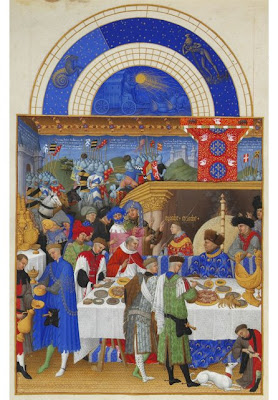I don't think so...
There's loads of information about the origins of pigments, how they were made and when they were introduced, but there is no differentiation between manuscripts and other art froms, so I can only conclude that the pigments were used unviseraly.
History of pigments can be found here along with loads of other pigment-related information.
Randy Asplund is an illuminated manuscript artist and on this page of his extensive web site he explains how he makes medieval paint for use in his art. These are the colours he creates:

Wikipedia also has an interesting table on medieval artist's colour sources.
We take full, saturated colour for granted these days, whether in the real or virtual world. The intensity of colour used in even the earliest manuscripts is astounding. This Book of Kells was produced in about 800AD by Celtic Monks.

I'm also taken by the way the textual content seems almost secondary to the illustrations. For example, half way down the first column on page 3 of the Sherborne Missal the illustration takes up 2/3 of the column and the text has been made smaller that the rest of the page to fit around it.

More spectacular Sherborne Missal pages
1 and 2

and 11 and 12. As you can see from the enlarged section, the amount of detail and the vibrant colours are amazing.

"This early 15th-century manuscript is probably the largest and most lavishly decorated English medieval service book to survive from the Middle Ages." (http://www.bl.uk/onlinegallery/sacredtexts/sherborne.html). A virtual copy of the Missal can be found here.
Les Très Riches Heures du Duc deBerry
Berry
And in regard to the colours they used:
More of this incredible manuscript can be found here and here.

Wikipedia also has an interesting table on medieval artist's colour sources.
We take full, saturated colour for granted these days, whether in the real or virtual world. The intensity of colour used in even the earliest manuscripts is astounding. This Book of Kells was produced in about 800AD by Celtic Monks.

I'm also taken by the way the textual content seems almost secondary to the illustrations. For example, half way down the first column on page 3 of the Sherborne Missal the illustration takes up 2/3 of the column and the text has been made smaller that the rest of the page to fit around it.

More spectacular Sherborne Missal pages
1 and 2

and 11 and 12. As you can see from the enlarged section, the amount of detail and the vibrant colours are amazing.

"This early 15th-century manuscript is probably the largest and most lavishly decorated English medieval service book to survive from the Middle Ages." (http://www.bl.uk/onlinegallery/sacredtexts/sherborne.html). A virtual copy of the Missal can be found here.
Les Très Riches Heures du Duc de
And in regard to the colours they used:
“The Limbourgs used a wide variety of colours obtained from minerals, plants or chemicals and mixed with either arabic or tragacinth gum to provide a binder for the paint. Amongst the more unusual colours they used were vert de flambe, a green obtained from crushed flowers mixed with massicot, and azur d'outreme, an ultramarine made from crushed Middle Eastern lapis-lazuli, used to paint the brilliant blues. (This was, of course, extremely expensive!)”
http://humanities.uchicago.edu/images/heures/heures.html
More of this incredible manuscript can be found here and here.



Bonnie,
ReplyDeleteMr. Asplund's colors are lovely, however, his Vermillions and Alizarines are a bit pink on his chart above. This may be due to the jpg. Illuminators of the distant past rarely, if ever, working with bright pinks. Most of their reds were either "fire engine reds", clay colored reds or on a very rare occasion, they might have painted with a very bloody red, I think.
Modern illuminators have access to many more colors.
Do other modern illuminators make their own paints as Mr Asplund or is he an exception?
ReplyDelete